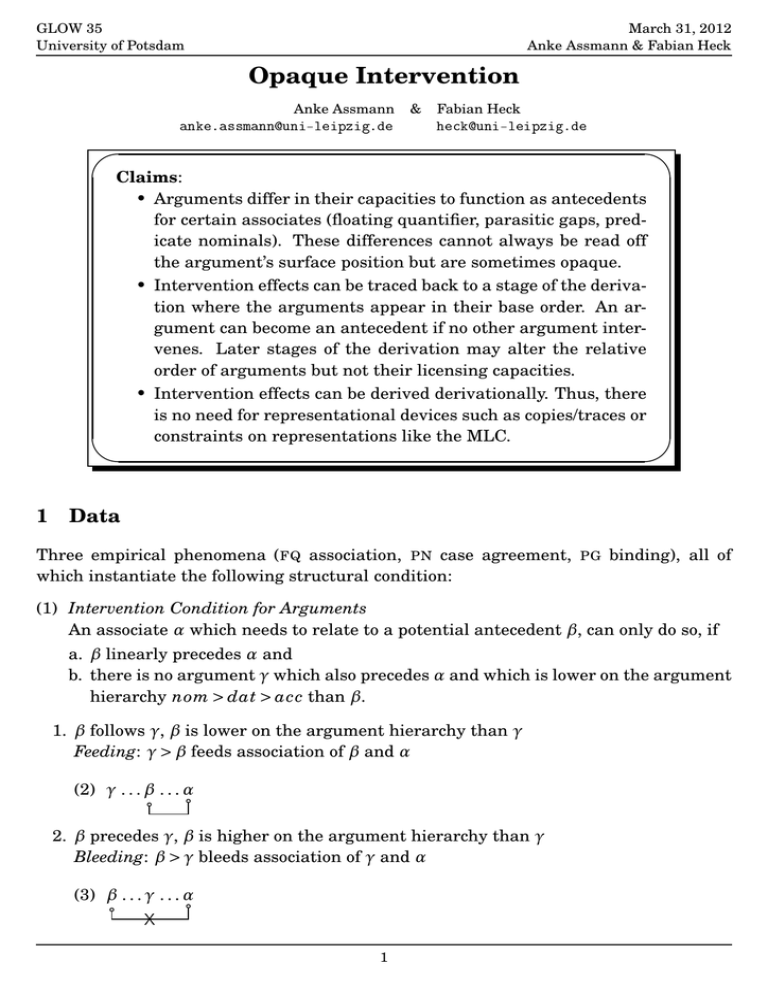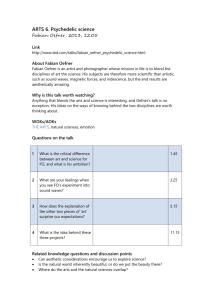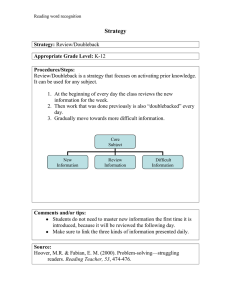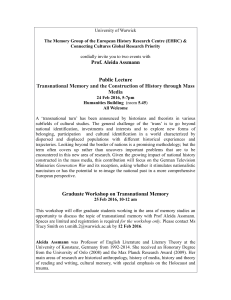Opaque Intervention - Universität Leipzig
advertisement

GLOW 35 University of Potsdam March 31, 2012 Anke Assmann & Fabian Heck Opaque Intervention Anke Assmann anke.assmannuni-leipzig.de ✬ & Fabian Heck hekuni-leipzig.de Claims: • Arguments differ in their capacities to function as antecedents for certain associates (floating quantifier, parasitic gaps, predicate nominals). These differences cannot always be read off the argument’s surface position but are sometimes opaque. • Intervention effects can be traced back to a stage of the derivation where the arguments appear in their base order. An argument can become an antecedent if no other argument intervenes. Later stages of the derivation may alter the relative order of arguments but not their licensing capacities. • Intervention effects can be derived derivationally. Thus, there is no need for representational devices such as copies/traces or constraints on representations like the MLC. ✫ ✩ ✪ 1 Data Three empirical phenomena (FQ association, PN case agreement, PG binding), all of which instantiate the following structural condition: (1) Intervention Condition for Arguments An associate α which needs to relate to a potential antecedent β, can only do so, if a. β linearly precedes α and b. there is no argument γ which also precedes α and which is lower on the argument hierarchy nom > dat > acc than β. 1. β follows γ, β is lower on the argument hierarchy than γ Feeding: γ > β feeds association of β and α (2) γ . . . β . . . α 2. β precedes γ, β is higher on the argument hierarchy than γ Bleeding: β > γ bleeds association of γ and α (3) β . . . γ . . . α X 1 GLOW 35 University of Potsdam March 31, 2012 Anke Assmann & Fabian Heck 3. β follows γ, β is higher on the argument hierarchy than γ Counter-Feeding: γ > β does not feed association of β and α (4) γ . . . β . . . α X 4. β precedes γ, β is lower on the argument hierarchy than γ Counter-Bleeding: β > γ does not bleed association of β and α (5) β . . . γ . . . α Conclusion: Intervention effects of this kind are not subject to linear order but only to the hierarchy nom > dat > acc. 1.1 Floating Quantifier alles (“all”) • The floating quantifier (FQ) alles in German obligatorily associates with a whphrase, independent of its grammatical function (6), (8)-(9) (Pafel 1991; Reis 1992). • Intervention effects occur when an indefinite non-wh-argument that is lower on the argument hierarchy than β precedes alles (7) vs. (8). • Definite arguments never intervene (6), (9) (6) Wer1 hat euch alles1 geholfen? helped whonom has you all “Who all helped you?” (7) a.*Wer1 hat einem Professor alles1 gedankt? whonom has a professordat all thanked “Who all thanked a professor?” b.*Wer1 hat einen Professor alles1 kennen gelernt? whonom has a professoracc all met “Who all met a professor?” c.*Wem1 hat sie einen Professor alles1 vorgestellt? whodat has she a professoracc all introduced “To whom all did she introduce a professor?” (8) a. Wem1 hat ein Professor alles1 geholfen? whodat has a professornom all helped “Who all did a professor help?” b. Wen1 hat ein Professor alles1 beleidigt? whoacc has a professornom all insulted “Who all did a professor insult?” 2 GLOW 35 University of Potsdam March 31, 2012 Anke Assmann & Fabian Heck c. ?Wen1 hat sie einem Professor alles1 vorgestellt? whoacc has she a professordat all introduced “Who all did she introduce to a professor?” (9) Wer1 hat dem Professor alles1 gratuliert? whonom has the professordat all congratulated “Who all congratulated the professor?” 1.2 Case Agreement • In Czech, predicate nominals (PN) can be formed by prefixing a noun phrase by the particle jako or coby (“as”). Such a PN case-agrees with the argument it predicates over (10)-(11). • Intervention effects occur when two wh-phrases precede the PN due to multiple wh-fronting. Note that there is no superiority; any wh-phrase can be clause-initial. Only the wh-phrase which is lowest on the argument hierarchy may associate with the PN, independent of the wh-phrases’ order. (11) vs. (12), (13-a) vs. (13-b), (13-c). (10) Komu Jirka představil jako dobrému příteli toho inženýra? whodat Jirka introduced as good frienddat the engineeracc “To whom did Jirka introduce the engineer as a good friend?” (11) a. Koho komu Jirka představil jako dobrého přítele? whoacc whodat Jirka introduced as good friendacc “Who did Jirka introduce to whom as a good friend?” b. Komu koho Jirka představil jako dobrého přítele? whodat whoacc Jirka introduced as good friendacc (12) a.*Koho komu Jirka představil jako dobrému příteli? whoacc whodat Jirka introduced as good frienddat “Who did Jirka introduce to whom as a good friend?” b.*Komu koho Jirka představil jako dobrému příteli? whodat whoacc Jirka introduced as good frienddat (13) a. Koho kdo představil jako dobrého přítele Jirkovi? whoacc whonom introduced as good friendacc Jirkadat “Who introduced whom as a good friend to Jirka?” b.*Kdo koho2 představil coby jeho2 dobrý přítel Jirkovi? whonom whoacc introduced as his good friendnom Jirkadat “Who as his good friend introduced whom to Jirka?” c.*Koho2 kdo představil coby jeho2 dobrý přítel Jirkovi? whoacc whonom introduced as his good friendnom Jirkadat 3 GLOW 35 University of Potsdam March 31, 2012 Anke Assmann & Fabian Heck 1.3 Parasitic Gaps • Parasitic gaps (PG) in German can be bound by objects which undergo wh-movement or scrambling (see Bayer 1984; Fanselow 1993; Lutz 2001 for wh-movement; Mahajan 1990; Webelhuth 1992; Grewendorf and Sabel 1999 for scrambling). • If both the indirect (dat) object and the direct (acc) object precede the PG adjunct clause, only the direct object can bind the PG (14-a) vs. (14-b); (15) vs. (16). (Subjects can never bind PGs for independent reasons; cf. Mahajan 1990; Fanselow 1993; Müller 1995) • Subjects never intervene (17) (Fanselow 1993). • The indirect object may only bind the PG if the direct object binds another PG (18) (Fanselow 1993; Kathol 2001). (14) a.*Wem2 hat der Fritz das Buch [anstatt PG2 zu helfen] weggenommen? whodat has the Fritz the bookacc instead to help away taken “From whom did Fritz take the book instead of helping him?” b. Was2 hat der Fritz der Maria [anstatt PG2 wegzuwerfen] zu essen whatacc has the Fritz the Mariadat instead away to throw to eat angeboten? offered “What did Fritz offer Maria to eat instead of throwing it away?” (15) a.*wenn jemand der Maria2 das Buch [anstatt PG2 zu helfen] wegnimmt if someone the Mariadat the bookacc instead to help away takes “if someone takes the book from Maria instead of helping her” b.*dass Hans das Buch der Maria2 [ohne PG2 zu vertrauen] geliehen hat that Hans the bookacc the Mariadat without to trust lent has “that Hans has lent Maria the book without trusting her” (16) a. dass Hans der Maria das Buch2 [ohne PG2 durchzulesen] zurückgibt that Hans the Mariadat the bookacc without through to read back gives “that Hans returns the book to Maria without reading it through” b. dass Hans das Buch2 der Maria [ohne PG2 durchzulesen] zurückgibt that Hans the bookacc the Mariadat without through to read back gives “that Hans returns the book to Maria without reading it through” (17) a. wenn der Anette2 jemand [anstatt PG2 zu gratulieren] kondoliert hat if the Anettedat someonenom instead to congratulate condoled has “if someone condoled with Anette (on s.th.) instead of congratulating her (on it)” (18) wenn jemand der Anette2 das Buch3 [anstatt PG2 PG3 zu schenken] leiht if someone the Anettedat the bookacc instead to give borrows “if one borrows Anette the book instead of giving it to her as a present” 4 GLOW 35 University of Potsdam March 31, 2012 Anke Assmann & Fabian Heck 2 Theoretical Background and Assumptions Framework: • Probe-goal framework (Chomsky 2000, 2001, 2007) • Two operations: Move and Agree take place when probe and goal are in a c-command configuration; Move is subject to the PIC in (19) (19) Phase Impenetrability Condition: The domain of a head H of a phase HP is not accessible to operations outside of HP. Only H and its edge domain are accessible. (20) Edge Domain: α is in the edge domain of β iff α is not a genuine complement of β. • α is a genuine complement of β if and only if α and β are sisters and β does not possess any specifiers. • The Strict Cycle Condition (SCC, Chomsky 1973) holds. (21) Strict Cycle Condition: If Σ is the root of the current phrase marker, then no operation can take place exclusively within Ω, where Ω is dominated by Σ. • Agree and Move obey the Earliness Principle (Pesetsky 1989) (22) Earliness Principle: A syntactic operation must apply as soon as its configurational requirements are fulfilled. Edge Features: • Operations are feature-driven. Operation triggering features are ordered on stacks. • Successive-cyclic movement is driven by edge features (EF). • Edge Feature Condition (EFC): EFs can be inserted on a head H only if H is still active, that is, if H bears at least one other feature that needs to be discharged (by Merge or Agree) (Müller 2010, 2011). • The features of a head are ordered on stacks; EF insertion targets the top of the stack. Since only the top of the stack is accessible, an EF must be discharged before other structure building operations can be triggered. Thus, the EFC leads to the Intermediate Step Corollary (ISC; Müller 2010, 2011) (23) Intermediate Step Corollary: Intermediate movement steps to specifiers of X (triggered by EFs) must take place before the final specifier is merged in XP. 5 GLOW 35 University of Potsdam March 31, 2012 Anke Assmann & Fabian Heck • Example: successive-cyclic wh-movement to Spec,vP (24) Step a. Configuration Feature Stack of v uD ... [v′ v [VP . . . wh . . . ]] EF b. EF insertion: [v′ v [VP . . . wh . . . ]] uD ... EF c. Move wh: [v′ wh v [VP . . . twh . . . ]] d. EF deletion: [v′ wh v [VP . . . twh . . . ]] uD ... e. Merge DP: [vP DP wh v [VP . . . twh . . . ]] uD ... f. u D deletion: [vP DP wh v [VP . . . twh . . . ]] ... uD ... Scrambling: • In German and Czech, Scrambling is triggered by EFs. • EFs can be inserted (at least) on v and T. Hence, scrambling can target the vP and the TP domain. Parallel Movement and MLC: • Multiple attraction by the same head is often order preserving, i.e., movement applies “in parallel”. • Example: Object shift in Danish (Vikner 1989, 1995)—pronouns in the VP are moved to Spec,vP. (25) a. Peter viste hende2 den3 jo t2 t3 . Peter showed her it indeed “Peter indeed showed it to her.” b.*Peter viste den3 hende2 jo t2 t3 . Peter showed it her indeed • Adopting both the Minimal Link Condition (MLC) (Fanselow 1991; Ferguson 1993; Chomsky 1995) in (26) and the SCC in (21) leads to a derivation like in (27). 6 GLOW 35 University of Potsdam March 31, 2012 Anke Assmann & Fabian Heck (26) Minimal Link Condition: If in a structure α . . . [. . . β . . . [. . . γ . . .] . . .] both β and γ are of the right type to establish a relation R with α, then α can establish R only with β (but not with γ). ➁ (27) *[ vP den3 hende2 . . . [ VP . . . t2 t3 . . . ] ] ➀ • Consequently, one has to give up either the SCC or the MLC. Here we suggest that the MLC should be dispensed with (see also Hunter and Malhotra 2009). • In order to derive parallel movement, we make the following assumptions: – A head can receive at most one EF per derivation. One EF can attract several goals. (This captures the idea that EFs may trigger multiple applications of Merge; see Chomsky 2007, 11.) – An EF scans down the tree for a goal G. Once a goal G1 is found, it may be placed on top of a stack S. If another goal G2 is found, it may be placed on top of G1 , etc. The search continues until the EF has exhausted its search space. – An EF can skip a potential goal G′ (there is no MLC) and continue its search. However, it may not return to G′ after having attracted a lower G. There is no backtracking. The search algorithm is completely local. – After the EF has finished its search, the elements on S are remerged in a lastin-first-out fashion as Specs of the head bearing the EF. • Example: Object shift in Danish: – A relativized EF (EF pron ) on v attracts pronouns from VP. – A feature [ u PRON] on the pronouns, which is checked if EF pron attracts the pronoun, ensures that object shift is obligatory. (28) Step a. Configuration [v′ v [VP . . . hende2 den3 . . . ]] S b. put hende2 on S: [v′ v [VP . . . t2 den3 . . . ]] hende2 c. put den3 on S: [v′ v [VP . . . t2 t3 . . . ]] den3 hende2 d. remerge den3: [v′ den3 v [VP . . . t2 t3 . . . ]] hende2 e. remerge hende2: [v′ hende2 den3 v [VP . . . t2 t3 . . . ]] 7 GLOW 35 University of Potsdam March 31, 2012 Anke Assmann & Fabian Heck 3 Analysis Main Idea in a Nutshell: • The associate α (FQ , PN, PG) is adjoined to VP and bears some probe feature [ u F] that needs to be checked by an antecedent with a matching feature [F]. • The ISC ensures that if an object move(s) to Spec,vP, it must be merged before the subject is merged ( nom > acc, nom > dat). • Parallel movement ensures that if both objects move to Spec,vP, the indirect object is remerged later than the direct object ( dat > acc) • Consequence: Due to the Earliness Principle (22), only the argument which is (re)merged first to the left of α enters into Agree with α. Case I: Object Intervenes between α and its Subject Antecedent • Due to the ISC, EF movement of the object must precede Merge of the subject. • If the object is a suitable antecedent for α, the object must associate with α as soon as it is remerged in Spec,vP (due to the Earliness Principle). • Since the subject is merged after α has found its antecedent, it cannot associate with α. (29) Step a. Configuration [v′ v [VP α[ u F] [VP . . . dat/acc1 [F] . . . ]]] b. EF movement: [v′ dat/acc1 [F] [v′ v [VP α[ u F] [VP . . . t1 . . . ]]]] c. Agree: [v′ dat/acc1 [F] v [VP α[ u F] [VP . . . t1 . . . ]]] d. Merge DPnom : [vP nom2 [F] dat/acc1 [F] v [VP α[ u F] [VP . . . t1 . . . ]]] X e. Agree impossible: [vP nom2 [F] dat/acc1 [F] v [VP α[ u F] [VP . . . t1 . . . ]]] Case II: Direct Object Intervenes between α and its Indirect Object Antecedent • In the VP, the indirect object is merged later than the direct object. • Due to parallel movement, the relative order of the objects is preserved in the vP, i.e., the direct object is remerged in Spec,vP before the indirect object. • Due to the Earliness Principle, the direct object must enter into Agree with the associate α as soon as it is merged in Spec,vP. • Since the indirect object is merged after α has found its antecedent, it cannot associate with α. 8 GLOW 35 University of Potsdam (30) March 31, 2012 Anke Assmann & Fabian Heck Step a. Configuration [v′ v [VP α[ u F] [VP dat2 [F] acc1 [F] ]]] S b. put dat on S: [v′ v [VP α[ u F] [VP t2 acc1 [F] ]]] dat2 c. put acc on S: [v′ v [VP α[ u F] [VP t2 t1 ]]] acc1 dat2 d. remerge acc: [v′ acc1 [F] v [VP α[ u F] [VP t2 t1 ]]] dat2 e. Agree: [v′ acc1 [F] v [VP α[ u F] [VP t2 t1 ]]] dat2 f. remerge dat: [v′ dat2 [F] acc1 [F] v [VP α[ u F] [VP t2 t1 ]]] X g. Agree impossible: [v′ dat2 [F] acc1 [F] v [VP α[ u F] [VP t2 t1 ]]] 3.1 Floating Quantifiers • Assume for sake of the argument that, semantically, alles must associate with a wh-phrase (but cf. Beck 1997). Non-wh-phrases cannot associate with alles. • Association requires syntactic Agree with respect to [ u INDEF] (on the FQ) and [IN DEF ] (on the indefinite). • Direct Consequence: Only indefinite arguments may associate with alles and, therefore, only indefinite arguments intervene for Agree (see Reis 1992). Case I: (31) Bleeding *Wer1 hat einem Professor alles1 gedankt? whonom has a professordat all thanked “Who all thanked a professor?” X ➁ (32) [ vP wer1 einem Professor2 v [ VP FQ [ VP t2 gedankt ]]] ➀ 9 GLOW 35 University of Potsdam March 31, 2012 Anke Assmann & Fabian Heck (33) Counter-Bleeding Wen1 hat ein Professor alles1 beleidigt? whoacc has a professornom all insulted “Who all did a professor insult?” ➁ (34) [ CP wen1 . . . [ vP ein Professor t′1 v [ VP FQ [ VP t1 . . . ]]]] ➂ ➀ Case II: (35) Bleeding *Wem1 hat sie einen Professor alles1 vorgestellt? whodat has she a professoracc all introduced “To whom all did she introduce a professor?” X ➁ (36) [ v’ wem1 einen Professor2 v [ VP FQ [ VP t1 t2 . . . ]]] ➀ ➂ 3.2 Case Agreement • PNs have a probing case feature [ u CASE] which must be checked by a DP with a matching feature [CASE]. • In multiple wh-fronting in Czech, only one wh-phrase moves to Spec,CP; all other wh-phrases move just as far as TP, due to a focus feature (Rudin 1988; Richards 2001; also Toman 1981, 298; see Meyer 2003 for certain qualifications). • The association capacities are already determined in the vP. • Since there is no MLC, there are two options for wh-movement from Spec,TP to Spec,CP: movement of the indirect object leads to bleeding and feeding; movement of the direct object leads to counter-bleeding and counter-feeding. Case II: (37) a. Feeding Komu2 koho1 Jirka představil jako dobrého přítele? whodat whoacc Jirka introduced as good friendacc “To whom did Jirka introduce who as a good friend?” b. Counter-Bleeding Koho1 komu2 Jirka představil jako dobrého přítele? whoacc whodat Jirka introduced as good friendacc 10 GLOW 35 University of Potsdam March 31, 2012 Anke Assmann & Fabian Heck c. Counter-Feeding *Koho1 komu2 Jirka představil jako dobrému příteli? whoacc whodat Jirka introduced as good frienddat “Who did Jirka introduce to whom as a good friend?” d. Bleeding *Komu2 koho1 Jirka představil jako dobrému příteli? whodat whoacc Jirka introduced as good frienddat X ➁ (38) [ vP Jirka komu2 koho1 v [ VP PN [ VP t2 t1 . . . ]]] ➂ ➀ ➂ (39) a. [ CP koho1 . . . [ TP komu2 t′1 . . . [ vP Jirka t2 t1 . . . PN . . . ]]] ➀ ➁ ➂ b. [ CP komu2 . . . [ TP t′2 koho1 . . . [ vP Jirka t2 t1 . . . PN . . . ]]] ➀ ➁ Case I: (40) a. Bleeding *Kdo1 koho2 představil coby jeho2 dobrý přítel Jirkovi? whonom whoacc introduced as his good friendnom Jirkadat “Who as his good friend introduced whom to Jirka?” b. Counter-Bleeding Koho2 kdo1 představil jako dobrého přítele Jirkovi? whoacc whonom introduced as good friendacc Jirkadat X ➁ (41) [ vP kdo koho2 v [ VP PN [ VP . . . Jirkovi t2 . . . ]]] ➀ 3.3 Parasitic Gaps • PGs and their antecedents must enter into an Agree relation (Assmann 2011). • A PG bears a probing feature [ u F] and a feature [D] while a potential antecedent bears a probing feature [ u D] and a feature [F]. • A PG may only associate with an antecedent that still possesses an unchecked [ u D] feature, i.e., the antecedent must be active for Agree with a PG. • Consequence: One antecedent can bind only one PG (but see Ross 1967). 11 GLOW 35 University of Potsdam March 31, 2012 Anke Assmann & Fabian Heck • Subjects may never bind a PG due to the anti-c-command condition (Chomsky 1982; Safir 1987) • A PG and its antecedent coincide with respect to case and animacy. Direct Consequence: A dative indirect object cannot bind an accusative PG and vice versa. Case II: (42) a. Feeding: dass Hans der Maria2 das Buch1 [ohne PG1 durchzulesen] zurückgibt that Hans the Mariadat the bookacc without through to read back gives “that Hans returns the book to Maria without reading it through” b. Counter-Bleeding: dass Hans das Buch1 der Maria2 [ohne PG1 durchzulesen] zurückgibt that Hans the bookacc the Mariadat without through to read back gives “that Hans returns the book to Maria without reading it through” c. Bleeding *wenn jemand der Maria2 das Buch1 [anstatt PG2 zu helfen] wegnimmt if someone the Mariadat the bookacc instead to help away takes “if someone takes the book from Maria instead of helping her” d. Counter-Feeding *dass Hans das Buch1 der Maria2 [ohne PG2 zu vertrauen] geliehen hat that Hans the bookacc the Mariadat without to trust lent has “that Hans has lent Maria the book without trusting her” X ➁ (43) [ vP jemand der Maria2 das Buch1 v [ VP [ . . . PG . . . ] [ VP . . . t2 t1 . . . ]]] ➂ ➀ Subsequent scrambling to Spec,TP may alter the order of the objects but not the binding possibilities. (44) Optional scrambling of the direct object to Spec,TP ➁ [ TP jemand3 das Buch1 . . . [ vP t3 der Maria2 t′1 . . . PG . . . ]] ➀ 12 GLOW 35 University of Potsdam March 31, 2012 Anke Assmann & Fabian Heck Multiple PGs: (45) Counter-Bleeding wenn jemand der Anette2 das Buch3 [anstatt PG2 PG3 zu schenken] leiht if someone the Anettedat the bookacc instead to give borrows “if one borrows Anette the book instead of giving it to her as a present” ➃ ➁ (46) [ vP jemand der Anette2 das Buch1 v [ VP [ . . . PG2 PG1 . . . ] [ VP . . . t2 t1 . . . ]]] ➂ ➀ 4 Further Issues 4.1 Verb Classes • Haider (1992, 1993, 2010) claims that different verb classes in German project different argument orders. • Class 1: indirect object > direct object (e.g. geben, vorstellen) • Class 2: direct object > indirect object (e.g. aussetzen, entziehen) • If this were true, one would expect that with Class 2 verbs it is the indirect object that relates to the associate (instead of the direct object). • (47) (PGs) and (48) (FQs) together with our theory seem to imply that the underlying order of all verbs is indirect object > direct object. (47) a. ?weil er das Kind2 dem Test [ohne PG2 zu schonen] aussetzte because he theacc child thedat test without to spare exposed “because he exposed the child to the test without sparing her” b.?*weil er das Kind dem Test3 [ ohne PG 3 zu trauen ] aussetzte because he theacc child thedat test without to trust exposed “because he exposed the child to the test without trusting it (the test)” c. weil er sie2 dem schlechten Einfluss [ ohne PG 2 zu befragen ] because he sheacc thedat bad influence without to ask entzog withdrew “because he withdrew her from the bad influence without consulting her” d.?*weil er sie dem schlechten Einfluss3 [ ohne PG 3 zu unterliegen ] because he sheacc thedat bad influence without to be subject entzog withdrew “because he withdrew her from the bad influence without being subject to it” 13 GLOW 35 University of Potsdam March 31, 2012 Anke Assmann & Fabian Heck (48) a. Wen2 hat er solchen Belastungen alles2 ausgesetzt? whoacc has he suchdat burdens all exposed “Who all has he exposed to such burdens?” b. *Welchen Belastungen2 hat er einen Freund alles2 ausgesetzt? Whichdat burdens has he aacc friend all exposed “To which burdens all has he exposed a friend?” c. Wen2 hat er schlechten Einflüssen alles2 entzogen? whoacc has he bad influencesdat all withdrawn “Who all did he withdraw from bad influences?” d. *Welchen schlechten Einflüssen2 hat er ein Kind alles2 entzogen? whichdat bad influences has he aacc child all withdrawn “From which bad influences all did he withdraw a child?” 4.2 Scrambling as a Transformation • Instead of analyzing scrambling as a transformation (see also Bierwisch 1963; Ross 1967; Fanselow 1990; Giusti 1990; Webelhuth 1992; Müller and Sternefeld 1994; Grewendorf and Sabel 1999), proponents of the base generation approach (Haider 1988; Fanselow 1993, 2001, 2003; Bayer and Kornfilt 1994; Kiss 1994; Neeleman 1994; Bošković and Takahashi 1998) argue that arguments can be freely merged in any order. • Leaving all other assumptions in place, base generation accounts have a hard time deriving the data presented in section 1: – In order to derive cases of bleeding (49-a), one could assume that wh-phrases are base-merged adjacent to the FQ and may not move across an indefinite; cf. (50). – But then, cases of counter-bleeding (49-b) are incorrectly ruled out as well; cf. (51). – To rule in cases of counter-bleeding, the base generator could allow the whphrase to be base-generated to the left of the indefinite, provided that intervention does not exist. – Without intervention, however, cases of bleeding are again ruled in. (49) a. Bleeding *Wem1 hat sie einen Professor alles1 vorgestellt? whodat has she a professoracc all introduced “To whom all did she introduce a professor?” b. Counter-Bleeding Wen1 hat sie einem Professor alles1 vorgestellt? whoacc has she a professordat all introduced “Who all did she introduce to a professor?” 14 GLOW 35 University of Potsdam March 31, 2012 Anke Assmann & Fabian Heck ➀ (50) [ CP wem1 . . . [ vP sie einen Professor t1 FQ X vorgestellt ]] ➀ (51) * [ CP wen1 . . . [ vP sie einem Professor t1 X FQ vorgestellt ]] 4.3 Tucking-in • Another way to account for parallel movement is the tucking-in approach (Richards 1997, 2001). • If two categories α and β are attracted by the same head H and α asymmetrically c-commands β, the transderivational constraint Shortest Paths (Chomsky 1995; Collins 1994; Nakamura 1998) ensures (i) that attraction proceeds in the order α > β and (ii) that β tucks in below α. (52) Shortest Paths: If two derivations D1 and D2 are in the same reference set and the movement paths of D1 are shorter than the movement paths of D2 , then D1 is to be preferred over D2 . ➀ (53) [ HP α2 β1 H . . . [ . . . t2 t1 ]] ➁ Problems with Tucking-in: 1. Tucking-in is not compatible with the SCC. 2. Tucking-in relies on a transderivational constraint. Since transderivational constraints are more complex than local constraints, a theory which only builds on local constraints is to be preferred. 3. Tucking-in is not compatible with a strictly derivational theory. • Consider (54). Given tucking-in and Earliness, the indirect object is expected to bind the PG, thereby blocking PG binding by the direct object, contrary to fact. • To avoid this, a theory that incorporates tucking-in must procrastinate Agree until the phrase is complete. The MLC blocks illicit PG binding. • This abandons the Earliness Principle (22) and extends the representational residue, which is against the tenet that derivational theories should minimize their representational residue (see Brody 2001). ➁ X (54) [ vP Hans der Maria3 das Buch2 [ . . . PG3 . . . ] t3 t2 . . . ] ➀ ➂ 15 GLOW 35 University of Potsdam March 31, 2012 Anke Assmann & Fabian Heck 5 Conclusion Main Claim: • Intervention effects with association of arguments with FQs and PGs in German and with PNs in Czech are often opaque and do not make reference to the surface order of arguments. • Opaque intervention can be derived by consulting previous stages of the derivation where the opacity has not arisen yet. Analysis: • Arguments are merged in a fixed hierarchy: nom > dat > acc, where “>” is “ccommands”. • Arguments may only associate with FQs/PNs/PGs if they c-command them. • Due to parallel movement, the hierarchy that is established with base generation obtains after movement. • Thus, acc and dat intervene for association of nom; acc intervenes for association of dat. • Subsequent movement of arguments may alter the structural hierarchy, but comes to late for altering the association capacities as well. Minimizing the Representational Residue: • We showed that intervention effects can be derived derivationally without reference to representational constraints such as the MLC. • Since in derivational theories the representational residue is to be minimized, no reference to traces/copies should be made either when accounting for intervention effects. References Assmann, Anke (2011), Deriving Parasitic Gaps by Fission und Fusion. Ms., Leipzig University. To appear in: Proceedings of ConSOLE XIX. Bayer, Josef (1984), ‘COMP in Bavarian Syntax’, The Linguistic Review 3, 209–275. Bayer, Josef and Jaklin Kornfilt (1994), Against Scrambling as an Instance of Move-α, in N.Corver and H.Riemsdijk, eds, ‘Studies on Scrambling. Movement and Non-Movement Approaches to Free Word-Order Phenomena’, Mouton de Gruyter, Berlin, pp. 17–60. Beck, Sigrid (1997), Wh-Constructions and Transparent Logical Form, PhD thesis, Universität Tübingen. Bierwisch, Manfred (1963), Grammatik des Deutschen Verbs, Studia Grammatica, Akademieverlag, Berlin. Bošković and Takahashi (1998), ‘Scrambling and Last Resort’, Linguistic Inquiry 29, 347–366. Brody, Michael (2001), Some Aspects of Elegant Syntax. Ms., University College London. Chomsky, Noam (1973), Conditions on Transformations, in S.Anderson and P.Kiparsky, eds, ‘A Festschrift for Morris Halle’, Holt, Reinhart and Winston, New York, pp. 232–286. Chomsky, Noam (1982), Some Concepts and Consequences of the Theory of Government and Binding, MIT Press, Cambridge, Massachusetts. Chomsky, Noam (1995), The Minimalist Program, MIT Press, Cambridge, Massachusetts. 16 GLOW 35 University of Potsdam March 31, 2012 Anke Assmann & Fabian Heck Chomsky, Noam (2000), Minimalist Inquiries: The Framework, in R.Martin, D.Michaels and J.Uriagereka, eds, ‘Step by Step: Essays on Minimalist Syntax in Honor of Howard Lasnik’, MIT Press, Cambridge, Massachusetts, pp. 89–155. Chomsky, Noam (2001), Derivation by Phase, in M.Kenstowicz, ed., ‘Ken Hale. A Life in Language’, MIT Press, Cambridge, Massachusetts, pp. 1–52. Chomsky, Noam (2007), Approaching UG from Below, in U.Sauerland and H.-M.Gärtner, eds, ‘Interfaces + Recursion = Language? Chomsky’s Minimalism and the View from Syntax-Semantics’, Mouton de Gruyter, Berlin, pp. 1–30. Collins, Chris (1994), ‘Economy of Derivation and the Generalized Proper Binding Condition’, Linguistic Inquiry 25, 45–61. Fanselow, Gisbert (1990), Scrambling as NP-Movement, in G.Grewendorf and W.Sternefeld, eds, ‘Scrambling and Barriers’, Benjamins, Amsterdam, pp. 113–140. Fanselow, Gisbert (1991), ‘Minimale Syntax’, Groninger Arbeiten zur Germanistischen Linguistik 32. Fanselow, Gisbert (1993), ‘Die Rückkehr der Basisgenerierer’, Groninger Arbeiten zur Germanistischen Linguistik 36, 1–74. Fanselow, Gisbert (2001), ‘Features, θ-Roles, and Free Constituent Order’, Linguistic Inquiry 32, 405–437. Fanselow, Gisbert (2003), ‘Free Constituent Order, A Minimalist Interface Account’, Folia Linguistica 37, 191–231. Ferguson, K. Scott (1993), ‘Notes on the Shortest Move Metric and Object Checking’, Harvard Working Papers in Linguistics 3, 65–80. Giusti, Giuliana (1990), ‘Floating Quantifiers, Scrambling, and Configurationality’, Linguistic Inquiry 21, 633–641. Grewendorf, Günther and Joachim Sabel (1999), ‘Adjunction vs. Multiple Specifiers. On Scrambling in German and Japanese’, Natural Language and Linguistic Theory 17, 1–65. Haider, Hubert (1988), Θ-Tracking Systems – Evidence from German, in L.Maràcz and P.Muysken, eds, ‘Configurationality’, Foris, Dordrecht, pp. 185–206. Haider, Hubert (1992), Branching and Discharge. Arbeitspapiere des Sonderforschungsbereichs 340, Nr. 23, Universität Stuttgart. Haider, Hubert (1993), Deutsche Syntax – Generativ, Narr, Tübingen. Haider, Hubert (2010), The Syntax of German, Cambridge University Press, Cambridge. Hunter, Tim and Shiti Malhotra (2009), Reassessing the Argument for Tucking-in. Ms., University of Maryland. Kathol, Andreas (2001), On the Nonexistence of True Parasitic Gaps in Standard German, in P. W.Culicover and P. M.Postal, eds, ‘Parasitic Gaps’, MIT Press, Cambridge, Massachusetts, pp. 315–338. Kiss, Katalin É. (1994), Scrambling as the Base-Generation of Random Complement Order, in N.Corver and H.Riemsdijk, eds, ‘Studies on Scrambling’, Mouton/de Gruyter, Berlin, pp. 221–256. Lutz, Uli (2001), Studien zu Extraktion und Projektion im Deutschen, PhD thesis, Univerität Tübingen. Mahajan, Anoop (1990), The A/A-bar Distinction and Movement Theory, PhD thesis, MIT, Cambridge, Massachusetts. Meyer, Roland (2003), On Multiple Wh-fronting and Wh-Clustering in Czech, in W.Browne, J.-Y.Kim, B. H.Partee and R. A.Rothstein, eds, ‘Formal Approaches to Slavic Linguistics 11. The Amherst Meeting 2002’, Michigan Slavic Publications, Ann Arbor, pp. 393–412. Müller, Gereon (1995), A-bar Syntax: A Study in Movement Types, Mouton de Gruyter, Berlin, New York. Müller, Gereon (2010), ‘On Deriving CED Effects from the PIC’, Linguistic Inquiry 41, 35–82. Müller, Gereon (2011), Constraints on Displacement, Benjamins, Amsterdam. Müller, Gereon and Wolfgang Sternefeld (1994), Scrambling as A-bar Movement, in N.Corver and H. v.Riemsdijk, eds, ‘Studies on Scrambling. Movement and Non-Movement Approaches to Free Word-Order Phenomena’, Mouton de Gruyter, Berlin, pp. 331–386. Nakamura, Masanori (1998), Reference Set, MLC, and Parametrization, in P.Barbosa, D.Fox, P.Hagstrom, M.McGinnis and D.Pesetsky, eds, ‘Is the best good enough? Optimality and competition in syntax’, MIT Press, Cambridge, Massachusetts, pp. 291–313. Neeleman, Ad (1994), Scrambling as a D-structure Phenomenon, in N.Corver and H. v.Riemsdijk, eds, ‘Studies on Scrambling. Movement and Non-Movement Approaches to Free Word-Order Phenomena’, Mouton de Gruyter, Berlin, pp. 387–430. Pafel, Jürgen (1991), Zum relativen Quantorenskopus im Deutschen. Arbeitspapiere des Sonderforschungsbereichs 340, Nr. 5, Universität Tübingen. Pesetsky, David (1989), Language Particular Processes and the Earliness Principle. Ms., MIT. Reis, Marga (1992), The Category of Invariant alles in Wh-Clauses: On Syntactic Quantifiers vs. Quantifying Particles in German, in R.Tracy, ed., ‘Who Climbs the Grammar Tree?’, Niemeyer, Tübingen, pp. 465–492. Richards, Norvin (1997), What Moves Where When in Which Language, PhD thesis, MIT, Cambridge, Massachusetts. Richards, Norvin (2001), Movement in Language, Oxford University Press, Oxford. Ross, John Robert (1967), Constraints on Variables in Syntax, PhD thesis, MIT, Cambridge, Massachusetts. Rudin, Catherine (1988), ‘On Multiple Questions and Multiple Fronting’, Natural Language and Linguistic Theory 6, 445–501. Safir, Ken (1987), ‘The Anti-C-Command Condition on Parasitic Gaps’, Linguistic Inquiry 18, 678–683. Toman, Jindřich (1981), Aspects of Multiple wh-Movement in Polish and Czech, in R.May and J.Koster, eds, ‘Levels of Syntactic Representation’, Foris, Dordrecht, pp. 293–302. Vikner, Sten (1989), ‘Object Shift and Double Objects in Danish’, Comparative Germanic Syntax 44, 119–141. Vikner, Sten (1995), Verb Movement and Expletive Subjects in the Germanic Languages, Oxford University Press, Oxford. Webelhuth, Gert (1992), Principles and Parameters of Syntactic Saturation, Oxford University Press, Oxford. 17 GLOW 35 University of Potsdam March 31, 2012 Anke Assmann & Fabian Heck Funding This research is partly funded by the DFG (Deutsche Gemeinschaft für Forschung) within the project “Lokale Modellierung nicht-lokaler Abhängigkeiten in der Syntax (local modeling of non-local dependencies in syntax). http://www.uni-leipzig.de/~lomo Contact Anke Assmann Universität Leipzig Institut für Linguistik Fabian Heck Universität Leipzig Institut für Linguistik anke.assmannuni-leipzig.de http://www.uni-leipzig.de/~assmann hekuni-leipzig.de http://www.uni-leipzig.de/~hek 18




